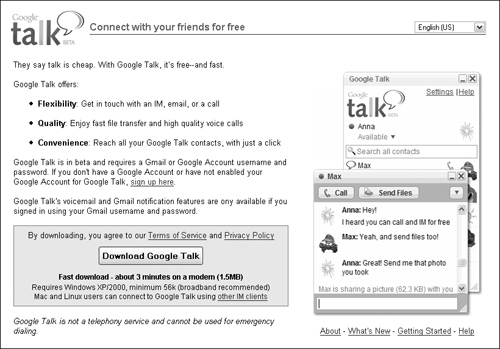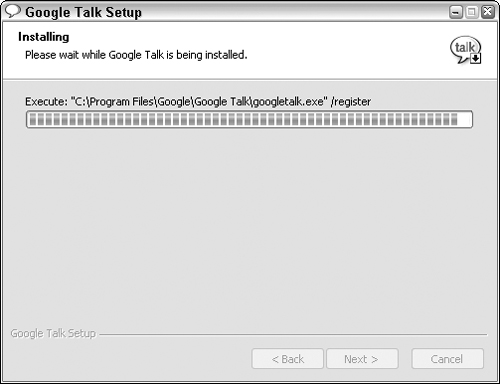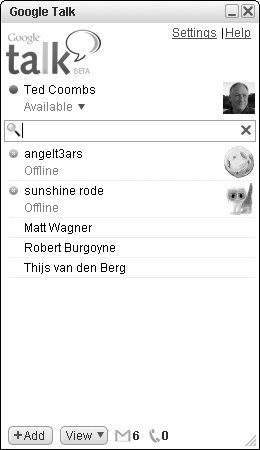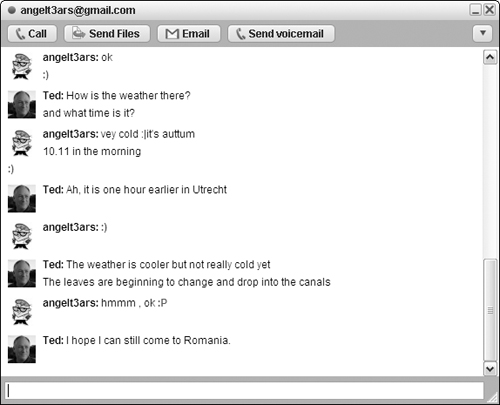Set up the Google Talk software
Let people know when you want to chat
Configure the Google Talk client
Get the most from your chats by saving your Chat history
Learn how to easily transfer files to your friends
Use Google Talk’s hands-free and enjoy talking instead of typing
Google Talk is an instant messenger program that allows you to chat with friends in a buddy list. It’s like many of the other instant messenger programs. See when people in your buddy list are online and when they are away. Chat with them, send them files, send your buddies e-mail, and send voice messages to them, all with Google Talk.
To get started using Google Talk point your browser to http://talk.google.com (see Figure 20.1). You can choose to see the Web page in your own language by selecting from the languages in the drop-down list in the upper-right corner of the page. This also takes you to the download of Google Talk in the same language. Click Download Google Talk to install a copy of Google Talk on your computer.
Note
When you click Download Google Talk, you automatically agree to the Terms of Service. Click the Terms of Service and Privacy Policy links above the button to read these terms and policies you are agreeing to follow.
After you download the Google Talk installation file to your computer (the file is named googletalk-setup.exe) open the file to launch the Google Talk installation program. When you agree to the terms (see the sidebar “The Terms”) installation starts (see Figure 20.2).
Click Finish to complete the Google Talk setup wizard. Google Talk will then launch on your computer.
When Google Talk launches, you are prompted to type either your Google account or Google Talk username and password. To make future Google Talk sessions simpler, you can opt to have the Google Talk client remember your password. If you are using a public computer, this process is not recommended. Deselect this option so that you must type a password even when someone already knows your username. Click Sign In and you are ready to start adding contacts.
After you log in, Google Talk loads all your Gmail contacts. For those who already have Gmail accounts, a small bubble appears next to their names. These people can begin receiving messages from you immediately.
Google loads your Gmail contacts in “Friend” order, not alphabetically. The people you e-mail the most must be your closest friends so they appear at the beginning of the Friend list. If you wonder how all your friends rate, Google tells you quickly by showing you where they all appear in the list based on the number of times you’ve swapped e-mail with them.
Even if you are familiar with other instant messaging programs, the Google Talk application has different features, so taking a small tour of the interface and setup is a good idea.
Look at Figure 20.3 and see that the Google Talk window lists you (me in this case) first and displays your online status. In this example, Google Talk shows I am online and available to receive Google Talk messages.
Your online status is displayed in the Google Talk windows of people who have you in their Friends list. You can change your status, which updates your friend’s display. Perhaps you’re busy and don’t want to be disturbed. Change your status to Busy. The status choices showing that you are available to receive messages are:
Available: Hey, send me an instant message!
Show current music track: Here’s the music I am listening to. Send me a message.
Custom message: Create a custom message telling people about your status.
When your status is busy you can still send and receive messages, but you’re telling your friends you’d rather not. This is a good status to be in when having a private chat with someone and not wanting to hear from others. The status choices for busy are:
Busy: Don’t bother me.
Show current music track: I am far too busy listening to music to be bothered. Here’s the song currently playing.
Custom message: Leave a custom busy message.
The last choice, Sign out, logs you off completely. This shows you as offline and unavailable to receive messages. You cannot send messages, either.
Online available status automatically changes to Idle, accompanied by an amber icon to signify when you are most likely not at your computer because you have not typed anything or moved your mouse in a while. Moving your mouse or typing changes your status back to Available.
You can easily change your online status by selecting a new status from the drop-down menu that displays your current status. You can leave available or busy custom messages by clicking on the current status, changing the status to a text box where you can type your custom message, or by selecting custom message from the drop-down menu. To change between available and busy custom messages you will need to select from the menu.
To change your Google Talk preferences, click the Settings link located at the top of the Google Talk window. The settings are divided into seven categories. Select a category in the list on the left and make changes to the selections in the right window.
The General settings allow you to change a number of important preferences. The first selection allows you to tell Google Talk whether to launch when you start Windows (log in to your account). When this option is selected, Google Talk launches each time you log in. Logging out of your account logs you off of Google Talk.
You can choose whether you want Google Talk to automatically launch Gmail when you click e-mail links. If Gmail is your primary e-mail program this makes sending e-mail messages from links much simpler. Otherwise, leave this deselected.
Control the appearance of your Friends list by selecting whether to sort your list alphabetically by name, hide your offline friends so you only see friends that are currently online, and hide the Google address book contacts that are not on your Friends list. The last choice in the friends-related selection tells Google whether to automatically add people you communicate with frequently to your Friends list. If you are uncertain or concerned about your privacy, it’s better to leave this deselected.
Click Change Font to change the font face and size used throughout the Google Talk application. This is particularly important for site-impaired individuals who may need a larger font size. It’s also a great way to express your personality.
Click Account Settings to launch a Web browser that allows you to change your Google account settings. The accounts page allows you to also review a list of your current services. If your list does not include all the wonderful things discussed in this book, you can quickly see what you need to add.
The Enable diagnostic logging button should not be selected unless a Google support engineer has requested that you do so. This creates a report sent to Google so that it can help diagnose problems you may be having with the Google Talk service.
There is a single choice in the Chat section having to do with how your chat history is handled. The first selection asks Google Talk to save a transcript in the Chats section of your Gmail account.
The second selection asks Google Talk not to save your chats. You can also keep others you are chatting with from saving your chat transcripts, no matter how they have this feature set by “going off the record.” This setting is explained later in the chapter.
The Blocked setting displays a list of usernames that you have blocked for whatever reason. You can change your mind or correct an accidental block by removing them from this list. Select the name in the list and click Unblock.
Set how you want to be notified when you receive an incoming call, an incoming chat request, when your friends come online, or when you receive e-mail in your Gmail account. For each event, you can choose the type of notification you’d like to receive. You can also turn off all notifications.
The connection settings are only important if your network requires the use of a proxy for Internet communications. You can choose to automatically detect and set firewall proxy settings or you can set them manually.
There is a special diagnostic tool for troubleshooting network connections. When asked by Google Support technicians, you can click Start Monitor.
The audio settings allow you to configure the hardware used when sending and receiving audio information from Google Talk. Audio information includes input and output hardware.
The last setting allows you to optionally share your music listening history with Google Music Trends. This helps Google track what people are listening to in order to report music trends.
Installing Google Talk isn’t much fun if you don’t have anyone else to share messages with. To add friends, click +Add at the bottom of the Google Talk window. The “Invite your friends to Google talk” dialog box appears. Type their e-mail addresses in the text box. When adding more than one at a time, separate the addresses with a comma. You can also select people from your Gmail contacts, making it easier to add all your friends at the same time. Click Next to go to the next step.
Each of the friends you add needs an account to sign up. Friends in your list who do not have a Google Talk account see a message informing them they need an account to take part along with the invitation Google sends on your behalf. They are invited to sign up and download Google Talk. You can edit the default message and customize it so that people know it is from you and not just spam. Click Next after typing your custom message. Google Talk tells you that your friends have been invited, and as soon as they accept the invitation, a colored ball appears next to each name indicating online status. Click Finish. Your invited friends appear in your Friends list without a ball and with the word (invited) next to their names.
When others want to add you to their Friends list, a message appears at the top of your Friends list identifying the potential friend and asking if you want to allow your name to be added. You can say yes, no, or block this person if you never want him or her to contact you again. People can always use fake identities and create new Google accounts. So blocking is no guarantee that you won’t hear from that person again.
Placing your mouse on anyone in your Friends list displays a pop-up with any custom icons or photos he or she might be using, along with that person’s status and e-mail address. You can click the following buttons to interact with the person:
Call
Send Files
Email
Options
Chat
Send voicemail
View past chats
Block friend
Click Call to alert your friends that you’d like to chat with them. A ring sound plays on your computer and your friend’s. Click Send Files to send a file. Learn more about sending files later in the chapter. Click Email to launch Gmail with a message already addressed to your friend.
If you click Options, a small drop-down menu appears. Click the down arrow in the upper-right corner to see four options. If you are not chatting, the first option is Chat. Select this option to open the chat window, which allows you to begin exchanging messages with your friends, as long as they are online. If you are already chatting, this option is “Go off the record.” Learn more about this selection in later in this chapter.
Send voicemail, the second menu option, allows you leave your friend a voice message. You must have a microphone installed to use this feature. When you finish sending your message, click End Call.
Selecting the View past chats option allows you to see chats you’ve had in the past. Google Talk saves your chats automatically unless you specifically tell Google Talk that you don’t want your chats saved. For more information about this setting see the section “Configuring Google Talk” later in this chapter. When you select View past chats, Gmail launches and displays a list of your past chats with that friend. Select one to view the entire chat transcript, including the time of day each message was sent or received.
Configure how friends appear in your Friends list by clicking View at the bottom of the window. Options include:
Show one page: This option shows only a single page of friends.
Sort by name: This option enables you to see your friends in alphabetical order.
Show pictures: This option displays the image your friend has chosen to appear in Google Talk communications.
Show offline friends: This option shows all friends, even those who have gone offline.
Show all address book contacts: This option shows people in your Gmail address book, even if they have not yet been added as friends in Google Talk. This easily lets you invite them to start using Google Talk.
Search for your friends by typing all or part of their names in the search box. You can only find friends that are already part of your Google Talk Friends list or Gmail contacts list.
Chatting begins when someone contacts you with a message, or you send someone a message. When someone sends you a message, a chat window opens where you can see the message displayed. Respond by typing in the box at the bottom of the window. Press Enter when you are ready to send your message.
If you want to initiate a chat session or simply send an instant message (technically the same thing), click a name in your Friends list and a chat window opens. Type a message and press Enter. If you friend is online, he or she receives your message.
In Figure 20.4, some of the chat messages are two lines long, and short lines so they didn’t wrap around. This is what happens when someone sends more than one chat message before receiving a response. Rather than redisplay your chat name and icon for each message, as other messengers do, Google Talk neatly displays them all as a single message.
As soon as your friend goes offline, you can no longer send him or her a message. Instead, Google Talk sends you a message that [email protected] is offline and can’t receive messages right now.
The transcripts of your chats can be saved in your Gmail account. It’s often handy to go back and refer to chats for things such as phone number, driving directions, or just to reminisce about all the nice things that were said. To view past chats, put your mouse over the friend’s name in your Friends list to open the popup window. From the drop-down menu select View past chats, which launches your Gmail account and displays all saved chats with this person. Select a chat session to view the contents. Each message also includes the time of day that messages were sent and received.
Your chat histories are treated like any other message stored in Gmail. You can archive them, delete them, star them, or anything else you can do with a Gmail message. Also, if you use Google Desktop to index all of your information, your chat histories are included in those searches.
You can select not to save chats transcripts by configuring your Chat settings. For extra privacy you can always select “Go off the record” to keep others from saving your chats in their Gmail accounts.
When you want your communications to remain relatively private you can take your chats off the record. While chatting with someone, click Options in the upper-right corner of the Chat window. The first selection is Go off the record.
Once this is set, it remains set for the current chat and all future chats until you choose to go back on the record. Setting this affects only chats with this friend. You have the option of saving chats or going off the record with each of your friends.
Going off the record does not guarantee that your chat transcripts are protected. In the Terms of Service, you may remember that you are allowed to access the Google Talk service using any Open application. This means that the non-Google Talk client may save chat histories to a place other than Gmail, meaning that even going off the record does not guarantee that your chat session will not be saved. Even when using the Google Talk client, the friend may choose to copy and paste your conversation from the chat window before closing it.
You can transfer any kind of file between Google Talk friends. To begin a file transfer, click Transfer File in either the message window or the pop-up that appears when you place your mouse cursor over a friend’s name in your Friends list.
Locate the file to be transferred on your computer and begin the transfer. You can watch its progress as it transfers.
The file transfer is peer-to-peer, which means that rather than send files to the Google server and then down to the person you’re chatting with, your computer makes a connection directly to the other person’s computer. This means that there are no limits on file types or file sizes that you can send between the two computers.
When you receive files sent to you, they are stored in the Google Talk Received Files folder. When someone sends you an image, it is stored in the Received Images folder, which is found within the Google Talk Received Files folder.
Tired of typing? Google Talk allows you to carry on two-way voice chats. Click Call in any chat window to begin a new voice chat. Both you and your friend must have the right audio equipment properly installed to use this feature.
Tip
Headsets equipped with a microphone work best for voice chatting. Most headset microphones are directional, eliminating much of the background noise. The earphones make your conversations easier to understand and may keep your audio chats a little more private.
Your Internet connection speed may affect the quality of your voice communications. This feature works with any connection speed but works best over DSL or faster connections.
To initiate a call, click Call, either in the Chat window or in the pop-up that appears when you mouse over a friend’s name. As soon as your friend answers, your voice communication begins. An indicator, like the one shown in Figure 20.5 appears, which shows your voice levels and allows you to end the call by clicking End Call.
You can have many voice calls connected at one time, but only one may be active. The other calls are put on hold. You cannot use this feature to access the normal telephone network, and therefore cannot use it to make emergency calls, unless it’s to tell your friend that pizza has suddenly become an emergency and to hurry over with some.
Closing the Google Talk window does not close the application. It continues to run, which is indicated by a Google Talk icon (a red M in a speech bubble) in your computer’s taskbar. To re-launch the Google Talk window, double-click on the icon in the taskbar.
To close Google Talk completely so that the application no longer runs on your computer, right-click the icon and select Exit from the pop-up menu. To restart Google Talk, start the application from you computer’s Start menu. Select All Programs ![]() Google Talk
Google Talk ![]() Google Talk.
Google Talk.
Use Google Talk to communicate with all your friends, either by typing instant messages, carrying on complete chat sessions, using voice chat, or if you can change your status fast enough, send Morse code messages. Okay, the last thing was just a joke. Get all your friends to sign up for Google Talk, whether they have Gmail accounts or not. The Google Talk client is free and easy to use and integrates well with your Gmail account.
To communicate with other Google Talk users and to stay on top of what’s new in Google Talk, try the Google Talk Blog at http://googletalk.blogspot.com/.
Google Talk is more than simply the Google Talk client. It’s an entire Open messaging service that can be accessed by many instant message clients. For a complete list of clients accessing the service, visit www.google.com/talk/otherclients.html.
Finally, because Google Talk does not support video chatting you will want to read the next chapter about how to use Picasa to share pictures with your friends.




